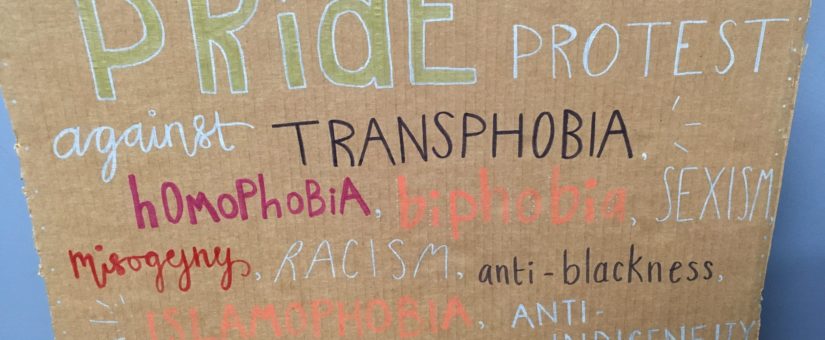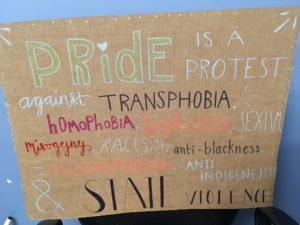
The Importance of Solidarity in our Anti-Violence Movements
WAVAW+BLM guest post
In advance of Sunday’s March on Pride, guest blogger and WAVAW volunteer Nicolle Wayara and her close friend and ally Daniella Barreto, an organizer with BLM-Vancouver, detail the ways that anti-violence movements are deeply connected, must stand in solidarity with one another, and how they might be able to learn from each other. Although formal and grassroots appeals calling for an end to violence against women have gradually become part of the public discourse, the two find it shocking that in 2017, a movement like BLM–one that demands an end to racist violence perpetuated against Black and other racialized communities by institutions like law enforcement–is met with scrutiny and derision (to say the least).
The backstory
Black Lives Matter is an international movement sparked after 17 year-old Trayvon Martin was killed and his murderer acquitted. BLM works against state violence and also to affirm the lives of the most marginalized Black folks (including queer & trans folks, disabled folks, and sex workers).
The impunity enjoyed by individuals, institutions, and governments that perpetuate violence against Black people is endemic in our societies, even when it comes to the police– an institution that ostensibly exists to protect and serve the public. Police violence is not only an issue in the United States, contrary to popular belief. Canada, a state built on white supremacy, violence, and ongoing colonialism, as well as sexual violence, continues to oppress Indigenous people and Black people in historically different yet similar systemic ways.
Drawing connections
In Canada, incarceration rates of Black and Indigenous people are wildly disproportionate, especially for Indigenous women, pointing to the over-policing and under-protection of marginalized groups by the armed wing of the state– law enforcement. Sex workers, many who are Indigenous, Black, PoC, and/or trans or queer (due to systemic issues that often deny these populations equal opportunities for education, employment, and housing), face increased physical and/or sexual violence when laws force them to work in more isolated areas to avoid police harassment. The Vancouver Police Department was also taken to the Human Rights Tribunal in 2015 for discrimination against trans people, and is far behind in updating trans policies and implementing changes. These are all systemic issues that affect the most marginalized women.
Anti-violence movements must recognize the intersections of more than just gender and race and scrutinize the ways oppression operates through systems of poverty, incarceration, migration, and sex work laws, just to name a few. These struggles against sexual violence and racial violence, while different in many key ways, are both deeply rooted in systemic oppression and a disregard for lives deemed “less valuable”.
Many parallels can be drawn between our anti-violence movements and, while sexual violence and rape culture are often addressed separately from racial violence and police brutality, these oppressions simultaneously interact with and build upon each other. As intersectional feminists committed to ending violence against women, WAVAW identifies rape culture as the most insidious tool through which sexualized violence against women and femmes operates. We know that on a systematic level, women are failed during and after their experiences of sexualized violence, both by law enforcement and the criminal justice system. Too often, these institutions disregard the experiences of women who seek their protection, and instead stigmatize their actions and identities as if being a woman was cause enough to deserve or invite violence. Fear of disbelief is real, and women often become strategic in their behaviour to defend themselves from shame, blame, and demonization when reporting their sexual assault.
In the same vein, BLM and other anti-racist collectives like BLM are often accused of “making it up” and being “too sensitive” when demands for police accountability, and racial justice are made.
As intersectional feminists, we must also acknowledge that the frequency of racialized sexual violence against Black and Indigenous women, trans women and non-binary femmes is a further manifestation of these intersecting oppressions along the lines of gender, race, and sexuality.
We cannot separate racial violence, sexual violence, homophobia, and transphobia with regards to their impact on the lived experiences of women who inhabit multiple social identities. All these identities exist within a larger system of systemic oppression, and feed into each other in a vicious cycle. BLM and WAVAW as anti-violence movements are incredibly similar even if they appear different.
Black women suffer both sexual violence and police violence –sometimes simultaneously. And we would be remiss if we did not acknowledge the ongoing violence experienced by Indigenous women. Recognizing the intersections and similarities across our movements makes our allyship informed and genuine. It makes us accountable to each other, and most importantly, it ensures that we show up for each other.
Let’s do just that.
Show up.
- On June 25, 2017


